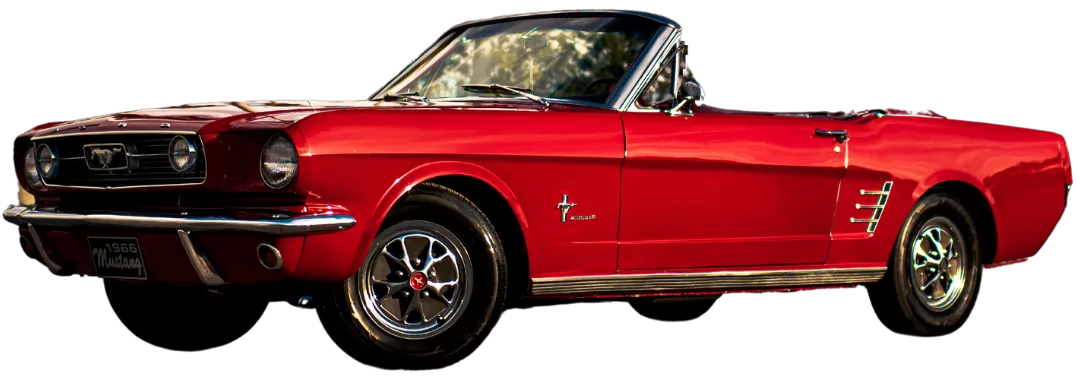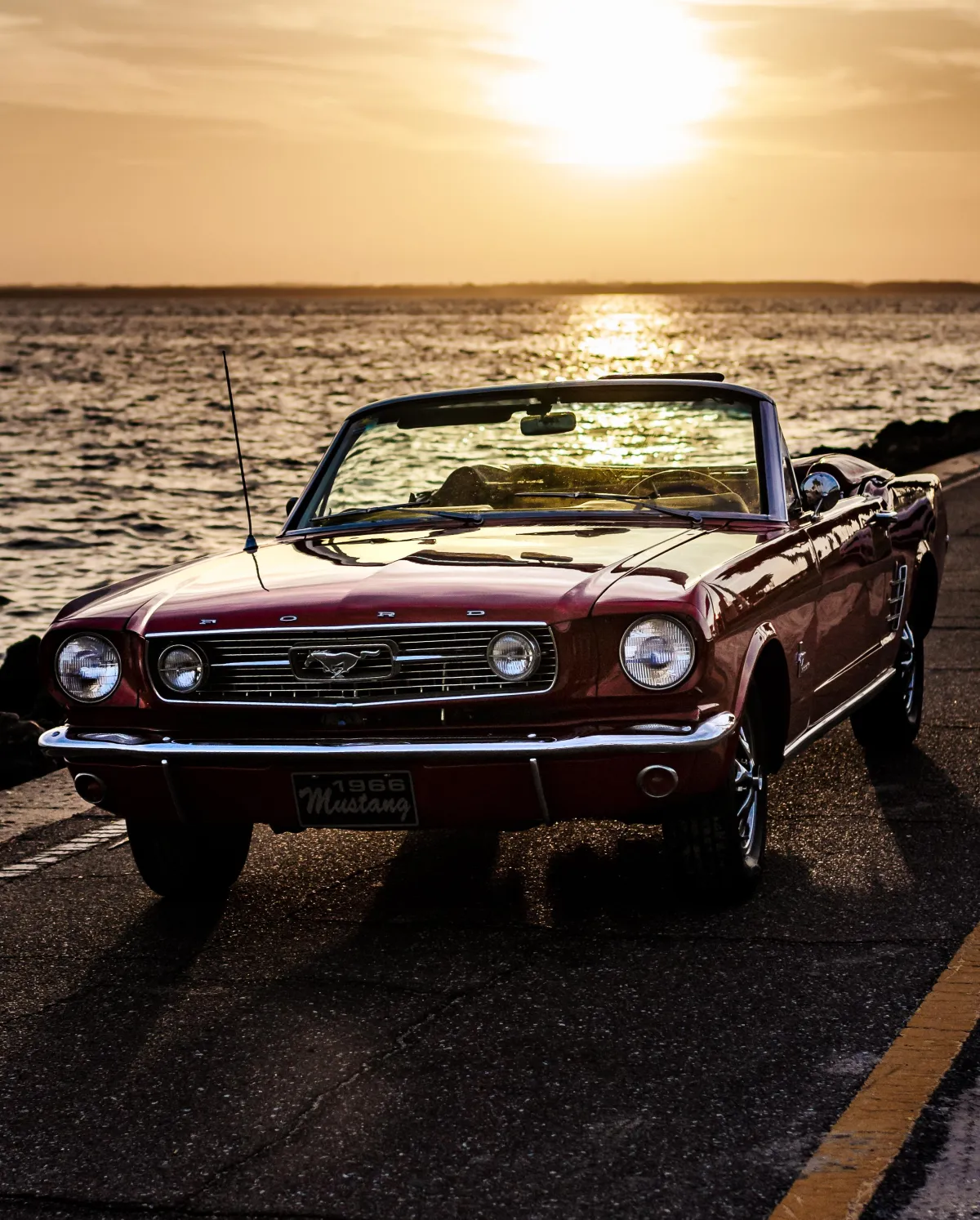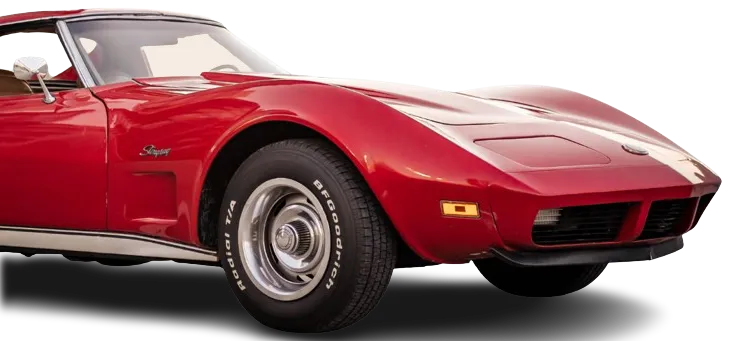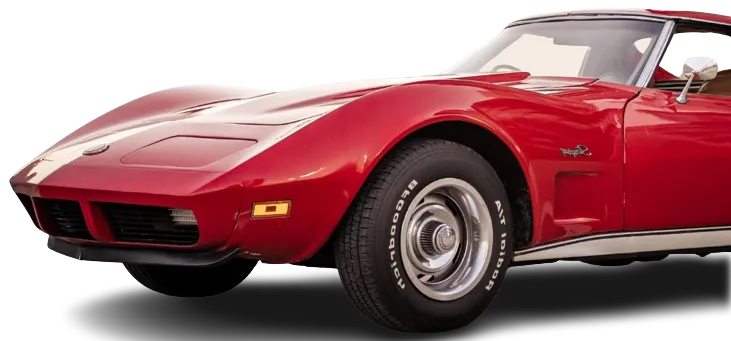Ford Mustang (1966)
Ford Mustang (1966)
One of the most famous American icons, the symbol of muscle cars and the originator of an entirely new category - the Mustang was Ford's sport car for the masses-and they quickly took it to their hearts.
SPECIFICATION:
Start of production: 1964
Engines:
170 cu in (2.8l), six cylinder;
200 cu in (3.3l), six cylinder;
260 cu in (4.3l), V8
289 cu in (4.7l), V8;
Transmissions:
3 – speed manual
3 – speed automatic
4 – speed manual
Fuel consumption: 10 mpg (min)
Top speed: 100 mph (min)
Fun fact: Origin of the Mustang name
No, this muscle car was not named after a horse, but after a plane.
According to the story, one of the Ford¢s designer John Najjar was fascinated with a World War II fighter plane known as the P-51 Mustang, widely considered the best American fighter plane of the Second World War era. So, it inspired him to choose that name.

One of the most famous American icons, the symbol of muscle cars and the originator of an entirely new category - the Mustang was Ford's sport car for the masses-and they quickly took it to their hearts.
SPECIFICATION:
Start of production: 1964
Engines:
170 cu in (2.8l), six cylinder;
200 cu in (3.3l), six cylinder;
260 cu in (4.3l), V8
289 cu in (4.7l), V8;
Transmissions:
3 – speed manual
3 – speed automatic
4 – speed manual
Fuel consumption: 10 mpg (min)
Top speed: 100 mph (min)
Fun fact: Origin of the Mustang name
No, this muscle car was not named after a horse, but after a plane.
According to the story, one of the Ford¢s designer John Najjar was fascinated with a World War II fighter plane known as the P-51 Mustang, widely considered the best American fighter plane of the Second World War era. So, it inspired him to choose that name.

The crystal ball used by the Ford¢s team, hired to predict what young and trendy people would like to drive in the mid-1960s proved to be spot-on.
And the answer was: Magical Mustang.
In late 1960, Lido (or 'Lee' as he liked to be called) lacocca had become head of Ford Division at the young age of 36. Recognizing the forthcoming shift in the market, he called for the creation of a new, affordable sports car. It was to follow the trend recently established by the General Motors Monza coupé for a smaller-scale American car and was to be made available with a vast range of options to make it affordable to the greatest number of buyers and types of drivers.
The design team received a detailed briefing: The car needs to have four seats, weight no more than 2,500 pounds (1,100 kg), need to have no more than 180 inches (5 m) in length and sell for less than $2,500. The designers set to work, not realizing that they were one step away from creating a timeless legend. After several prototypes, the final serial model was defined. Iacocca and product manager Donald Nelson Frey managed to develop a production model in just 18 months
Launched in April 1964 with a $10m promotional campaign that saw it on the covers of both Newsweek and Time magazines and revealed it to 30 million Americans through prime-time TV commercials, the Mustang went on sale at a starting price of $2,368. During the first weekend, it was available, an estimated four million people flocked to Ford dealerships around the country to see one in the flesh.
A remarkable 100,000 were sold in the first four months, with annual sales peaking in 1966 when Ford shifted 540,802. Few buyers bought the most basic version, however, with most adding at least $600 worth of options, ranging from whitewall tires ($33.90) to vinyl roofs ($75.80).
But there was much more to be had than that because Mustangs were soon available not only in the original “notchback” form but in convertible and fastback body styles, too. Up to twenty color options were offered along with six-cylinder or V8 engines of various capacities, manual or automatic gearboxes, and drum or disc brakes. Interiors could be specified with various levels of trim, instrumentation, and accessories.
The crystal ball used by the Ford¢s team, hired to predict what young and trendy people would like to drive in the mid-1960s proved to be spot-on.
And the answer was: Magical Mustang.
In late 1960, Lido (or 'Lee' as he liked to be called) lacocca had become head of Ford Division at the young age of 36. Recognizing the forthcoming shift in the market, he called for the creation of a new, affordable sports car. It was to follow the trend recently established by the General Motors Monza coupé for a smaller-scale American car and was to be made available with a vast range of options to make it affordable to the greatest number of buyers and types of drivers.
The design team received a detailed briefing: The car needs to have four seats, weight no more than 2,500 pounds (1,100 kg), need to have no more than 180 inches (5 m) in length and sell for less than $2,500. The designers set to work, not realizing that they were one step away from creating a timeless legend. After several prototypes, the final serial model was defined. Iacocca and product manager Donald Nelson Frey managed to develop a production model in just 18 months
Launched in April 1964 with a $10m promotional campaign that saw it on the covers of both Newsweek and Time magazines and revealed it to 30 million Americans through prime-time TV commercials, the Mustang went on sale at a starting price of $2,368. During the first weekend, it was available, an estimated four million people flocked to Ford dealerships around the country to see one in the flesh.
A remarkable 100,000 were sold in the first four months, with annual sales peaking in 1966 when Ford shifted 540,802. Few buyers bought the most basic version, however, with most adding at least $600 worth of options, ranging from whitewall tires ($33.90) to vinyl roofs ($75.80).
But there was much more to be had than that because Mustangs were soon available not only in the original “notchback” form but in convertible and fastback body styles, too. Up to twenty color options were offered along with six-cylinder or V8 engines of various capacities, manual or automatic gearboxes, and drum or disc brakes. Interiors could be specified with various levels of trim, instrumentation, and accessories.
Under the Hood
The first Mustang prototype had a V4 engine mounted in the middle, but (luckily) it wasn't what Iacocca wanted.
As befits a real muscle car, the serial model hides a powerful V8 engine under the hood, whose power and displacement vary depending on the version. When we talk about the period from 1964 to 1966, the least power is offered by the V8 260 cu in (4.3l) with 165 bhp, while the most powerful is the 289 cu in (4.7l) with 271 bhp.
But not every Mustang has eight cylinders under its long, flat hood. Entry-level early ones have a straight-six, and later ones have V6s. The standard engine in the 1966 Mustang was the 200 cu inline six-cylinder engine with a three-speed manual transmission, which produced 120 hp.
The engines can be connected to a manual or automatic transmission, through which they transmit power to the rear wheels.
Unfortunately, the Mustang also had bad days. Models of the early 1970s – the period of the great energy crisis, used a Ford Pinto-donated four-cylinder engine and, these models are the least popular.


Exterior
In the world of cars, the Ford Mustang is a well-known figure - something like a celebrity. The striking design of its bodywork is the most responsible for this. The Mustang has a recognizable athletic silhouette - a massive hood, behind it a cabin with two doors, and a short trunk at the end, regardless of whether it is a best-seller Hardtop, aggressive Fastback, or a graceful Convertible.
Typical for 1966, the offer included a palette of 16 colors, among which the red colors Signal Flare Red and Candy Apple Red proved very popular. The convertible version with red color is a winning combination. This color has a sporty note and p
erfectly emphasizes the elegant lines of the body. It also highlights the contrast very nicely related to the chrome details.
Over the years, the exterior has undergone just minor changes. The original product was such a hit that Ford didn’t want to change it too much. The 1965 and 1966 Mustangs are differentiated by variations in the exterior, despite the similar design. These modifications are cove molding on the rear quarter panels behind the doors. The molding had a single vertical piece of chrome beginning originally in August 1964. But for 1966 models, it was lower in height and featured three horizontal bars extending forward from the design. The front intake grilles and ornaments were also unique. The 1965 front grille had a "honeycomb" pattern, whilst the 1966 version was a "slotted" form.

Under the Hood
The first Mustang prototype had a V4 engine mounted in the middle, but (luckily) it wasn't what Iacocca wanted.
As befits a real muscle car, the serial model hides a powerful V8 engine under the hood, whose power and displacement vary depending on the version. When we talk about the period from 1964 to 1966, the least power is offered by the V8 260 cu in (4.3l) with 165 bhp, while the most powerful is the 289 cu in (4.7l) with 271 bhp.
But not every Mustang has eight cylinders under its long, flat hood. Entry-level early ones have a straight-six, and later ones have V6s. The standard engine in the 1966 Mustang was the 200 cu inline six-cylinder engine with a three-speed manual transmission, which produced 120 hp.
The engines can be connected to a manual or automatic transmission, through which they transmit power to the rear wheels.
Unfortunately, the Mustang also had bad days. Models of the early 1970s – the period of the great energy crisis, used a Ford Pinto-donated four-cylinder engine and, these models are the least popular.

Exterior
In the world of cars, the Ford Mustang is a well-known figure - something like a celebrity. The striking design of its bodywork is the most responsible for this. The Mustang has a recognizable athletic silhouette - a massive hood, behind it a cabin with two doors, and a short trunk at the end, regardless of whether it is a best-seller Hardtop, aggressive Fastback, or a graceful Convertible.
Typical for 1966, the offer included a palette of 16 colors, among which the red colors Signal Flare Red and Candy Apple Red proved very popular. The convertible version with red color is a winning combination. This color has a sporty note and p
erfectly emphasizes the elegant lines of the body. It also highlights the contrast very nicely related to the chrome details.
Over the years, the exterior has undergone just minor changes. The original product was such a hit that Ford didn’t want to change it too much. The 1965 and 1966 Mustangs are differentiated by variations in the exterior, despite the similar design. These modifications are cove molding on the rear quarter panels behind the doors. The molding had a single vertical piece of chrome beginning originally in August 1964. But for 1966 models, it was lower in height and featured three horizontal bars extending forward from the design. The front intake grilles and ornaments were also unique. The 1965 front grille had a "honeycomb" pattern, whilst the 1966 version was a "slotted" form.
Interior
The interior design follows the body style - sporty, yet charming and refined. Ford offered a wide variety of options for interior personalization, so it was easy for customers to make their Mustang unique. Therefore, it is not surprising that the text of one of the first advertisements was“Mustang is designed to be designed by you”. Actually, for 1966, Ford offered over 70 different options on their Mustangs.
Many '65-'66 Mustang owners looked for the Interior Decor Group option, often known as the Pony interior because of the running horses visible in the seatback inserts. That was one of the favorite details.
Do you want to go for a ride?
Of course, you do. The Mustang was created for cruising on open roads, and driving it is a unique experience, especially if you are driving the Convertible with a headwind. During fast cornering, the Mustang shows its age - you will feel body roll, but nothing excessive. Just enough to remind you that you are driving an old-timer – not the latest generation. Just as the body settles down, the Mustang changes direction. smooth and with a pleasant feel. For dynamic driving, the Mustang demands more engagement from the driver, but that's part of its charm that old-school enthusiasts will especially appreciate.
The 1966 Mustang has long been hailed for its comfortable and easy driving experience. The 200 cu in and 289 cu in engines are not known for being the quickest but are described as ‘work horses’ and are nigh on bomb-proof with regular upkeep.
The Mustang Mark I proved to be the first of a very long line of cars to bear the name. As the years went by, however, the Mustang gradually lost its character, first becoming larger, then slower, then smaller, and then, well, just rather mediocre until the fifth generation model was introduced in 2005- sporting a shape heavily inspired by the original. Which, as everyone knows, is always the best.
Interior
The interior design follows the body style - sporty, yet charming and refined. Ford offered a wide variety of options for interior personalization, so it was easy for customers to make their Mustang unique. Therefore, it is not surprising that the text of one of the first advertisements was“Mustang is designed to be designed by you”. Actually, for 1966, Ford offered over 70 different options on their Mustangs.
Many '65-'66 Mustang owners looked for the Interior Decor Group option, often known as the Pony interior because of the running horses visible in the seatback inserts. That was one of the favorite details.
Do you want to go for a ride?
Of course, you do. The Mustang was created for cruising on open roads, and driving it is a unique experience, especially if you are driving the Convertible with a headwind. During fast cornering, the Mustang shows its age - you will feel body roll, but nothing excessive. Just enough to remind you that you are driving an old-timer – not the latest generation. Just as the body settles down, the Mustang changes direction. smooth and with a pleasant feel. For dynamic driving, the Mustang demands more engagement from the driver, but that's part of its charm that old-school enthusiasts will especially appreciate.
The 1966 Mustang has long been hailed for its comfortable and easy driving experience. The 200 cu in and 289 cu in engines are not known for being the quickest but are described as ‘work horses’ and are nigh on bomb-proof with regular upkeep.
The Mustang Mark I proved to be the first of a very long line of cars to bear the name. As the years went by, however, the Mustang gradually lost its character, first becoming larger, then slower, then smaller, and then, well, just rather mediocre until the fifth generation model was introduced in 2005- sporting a shape heavily inspired by the original. Which, as everyone knows, is always the best.

Have Questions About Renting A Car?
813-699-9428

Copyright © 2024 Eternity Luxury Group. All Rights Reserved.

Have Questions About Renting A Car?
+1 813-531-9481

LOCATIONS
Tampa
COMING SOON
COMING SOON
COMING SOON
Copyright © 2024 Eternity Luxury Group. All Rights Reserved.

